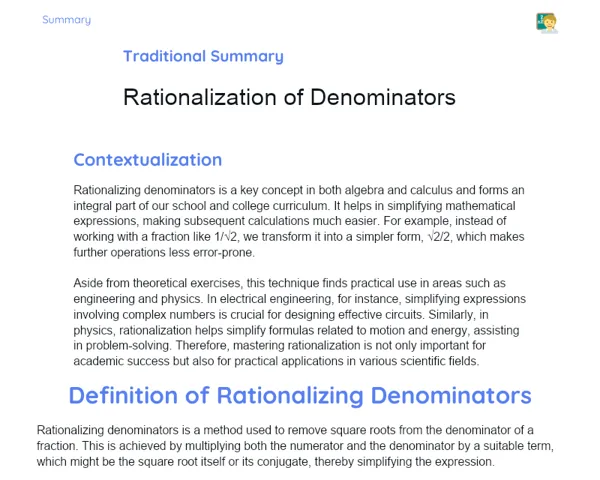Socioemotional Summary Conclusion
Goals
1. Understand that for two matrices to be equal, all their corresponding elements must be exactly the same.
2. Solve problems involving identifying elements and unknowns in equal matrices.
Contextualization
Did you know that the equality of matrices can be likened to teamwork? Just like a team needs all its members to be in sync and cooperate well to achieve their goals, two matrices can only be equal if all their corresponding elements are precisely aligned. Let’s delve into this concept and explore how it resonates with both mathematics and our personal relationships! 🌟
Exercising Your Knowledge
Concept of Equality of Matrices
The idea of matrix equality is a cornerstone in mathematics. Two matrices are considered equal when they share the same dimensions and every corresponding element matches. Understanding this principle is essential for tackling problems related to finding elements and unknowns in equal matrices, while also reflecting on the significance of harmony and alignment in our relationships.
-
Equal Dimensions: For two matrices to be deemed equal, they must have the same number of rows and columns.
-
Corresponding Elements: All elements in equivalent positions in the matrices should be equal.
-
Application in Problems: This equality principle is instrumental in solving mathematical challenges that require finding specific values that make two matrices equal, fostering analytical and problem-solving skills.
Formal Definition of Equality of Matrices
The formal definition gives a clear criterion for when two matrices are equal. Two matrices A and B of the same order m x n are equal if each element a(i,j) of A is equal to the element b(i,j) of B for all indices i and j. This concept underscores the importance of precision and clarity, whether in academics or in our communications and relationships.
-
Order of Matrices: The matrices should have the same order, representing the same count of rows and columns.
-
Elemental Equality: Every element at the position (i,j) of one matrix must exactly match the corresponding element of the other matrix.
-
Importance of Precision: Just like in mathematics, in our everyday interactions, clarity and precision are critical for genuine understanding.
Finding Unknowns in Equal Matrices
Determining unknowns so that matrices can be equal is a practical application of their equality. This involves assessing and comparing the corresponding elements to find the values that equalize the two matrices. By honing this skill, we not only solve mathematical problems but also develop patience, persistence, and collaborative skills in life.
-
Element Analysis: The first step is to compare the corresponding elements of the matrices.
-
Solving Equations: Finding the values of unknowns entails solving equations related to the differing elements.
-
Skill Development: Engaging in this practice bolsters analytical abilities and fosters resilience when confronting challenges.
Key Terms
-
Matrix Equality: When two matrices possess the same order and all corresponding elements are equal.
-
Matrix Order: Dimensions of a matrix, represented as m x n, where m is the number of rows and n is the number of columns.
-
Corresponding Elements: Elements that occupy the same positions in two different matrices.
For Reflection
-
How can grasping matrix equality enhance our appreciation for harmony and cooperation in our relationships?
-
In what ways can the precision required in matrix equality be harnessed to better our communication skills and clarity in social interactions?
-
What emotional strategies have you employed or could you adopt to manage frustrations when grappling with matrix problems? How might these strategies apply in other aspects of your life?
Important Conclusions
-
For two matrices to be equal, all their dimensions and corresponding elements must match.
-
Tackling problems that involve identifying elements and unknowns in equal matrices aids in cultivating analytical and problem-solving skills.
-
The concept of matrix equality highlights the need for harmony and alignment, both in relationships and in collaborative work.
Impacts on Society
Matrix equality plays a vital role in society, particularly in areas demanding precision and cooperation. In technology, for instance, algorithms depend on harmonious interactions among code components, akin to matrix elements. This concept is equally applicable in engineering, where structural components must align and coordinate for safety and efficiency.
On an emotional and social plane, a solid understanding of matrix equality can enhance our communication skills. Just as we ensure each element of a matrix is correct, we must strive for clarity in communication to prevent misunderstandings. This clarity paves the way for better interpersonal relations and fosters a more collaborative environment, both in academic settings and broader social contexts.
Dealing with Emotions
When studying matrix equality, acknowledge how you feel about the subject and why these emotions arise. You may feel challenged or a bit frustrated; try to articulate these feelings clearly. Next, share your emotions suitably, whether through a chat with a friend or journaling. Finally, manage your emotions through mindfulness practices like deep breathing or taking breaks before resuming your studies; these steps can help you maintain composure and focus when faced with complex problems.
Study Tips
-
Practice solving matrix equality problems in small groups to benefit from collaborative feedback.
-
Utilize online resources like videos and tutorials that offer diverse explanations and examples.
-
Take periodic breaks while studying to engage in deep breathing techniques, helping to sustain focus and alleviate stress.



